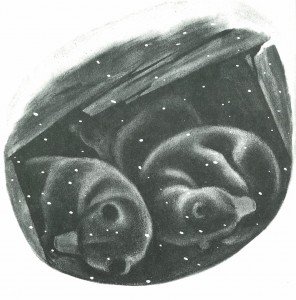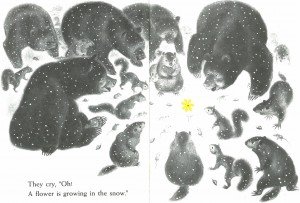A reasonable response to an episode, or perhaps a lifetime of gluttony is a return to simplicity. I am, of course referring to gluttony of the eyes and I believe there is nothing wrong with this sort of extravagance per se, or at least I hope there isn’t as I am at all times surrounded by visual brilliance. Complex masterpieces line my walls and bookshelves, and in spite of my great esteem for the achingly lovely, it can be, on occasion, too much. A book such as The Happy Day by Ruth Krauss is like a lemon sherbet in a world of thickly iced chocolate cakes. It’s minimalist approach is just the thing for an overstimulated brain, and though it seems quaintly vintage in some respects, the sweet story and gentle illustrations make it timeless. It is still an extravagance, but it’s a whisper, not a shout.
The story opens in a snowy field, where the hills have been magically scrubbed to reveal the cozy hidy-holes of sleeping mice, bears, ‘little snails asleep in their shells’, squirrels, and groundhogs. A winter world in hibernation, until…the creatures begin to stir; the mice open their eyes, sleepy bears poke their snouts out of their dens~something is definitely in the air.
of sleeping mice, bears, ‘little snails asleep in their shells’, squirrels, and groundhogs. A winter world in hibernation, until…the creatures begin to stir; the mice open their eyes, sleepy bears poke their snouts out of their dens~something is definitely in the air.
“They sniff. They run. The field mice run, the bears run…the ground hogs run out of the ground.”
It’s a virtual stampede to whatever it is that is captivating the animal’s attention, drawing them out of their winter slumber. It is simply, a flower, growing out of the snow. Clearly these are Canadian animals, held hostage by six months of brutal winter, awakened by the sudden presence of life. I understand their rapturous celebration. I saw a my first flower growing out of the dirt two weeks ago and I was almost hysterical.
The achromatic pencil and chalk illustrations of the animals are loosely detailed and exceptionally charming without being sickeningly anthropomorphic. The only colour is the yellow flower, and in contrast to the subdued tones in rest of the book, it is a deeply pleasurable, glorious thing. Like a crocus in spring, or reading The Happy Day for the first time. Or the second.
Interestingly, my colleague saw the book on my desk at work and was immediately transported back to her childhood. She remembered reading it as a kid, and being particularly taken with the snails. I bought the book within the last fifteen years, so while it holds no memories, it certainly infuses me with a kind of nostalgia for fifties and sixties children’s picture book classics. The Happy Day is clearly written for children. Just like contemporary children’s movies, contemporary children’s books almost always contain a nod to the adult audience. The double-entrendre is de rigueur. Not so in The Happy Day, and other books of that era. When Ruth Krauss wrote The Happy Day, she had three and four year-olds in mind. Nevertheless, the book appeals to all ages, especially those who live in northern climates.
Ruth Krauss was born in Baltimore, where she attended the Peabody Institute of Music. She received a bachelor’s
degree from the Parsons School of Fine and Applied Art in New York City. Over the next four decades, she wrote over 30 books for children, many of them illustrated by her husband, David Johnson Leisk, who wrote children’s books under the pen name Crockett Johnson (Harold & the Purple Crayon.) Eight of Ms. Krauss’s books were illustrated by Maurice Sendak, beginning in 1952 with A Hole Is to Dig. Other titles in her resume include The Carrot Seed, A Hole Is to Dig, Caldecott Honor Book A Very Special House, Open House for Butterflies, I Want to Paint My Bathroom Blue, Bears, The Growing Story, and Caldecott Honor Book The Happy Day. At a time when children’s books tended to be didactic (many still are), with lots of words, Krauss pioneered the use of minimal text, with precise language. (Similar in some respects to Dr Seuss, but with fewer Sneeches.) Ms Krauss passed away in 1993.
Marc Simont was born in 1915 in Paris. His parents were from the Catalonia region of Spain, and his childhood was spent in France, Spain, and the United States. Encouraged by his father, Joseph Simont, an artist and staff illustrator for the magazine L’Illustration, Marc Simont drew from a young age. He settled in America, and his first illustrations for a children’s book appeared in 1939. Since then, Mr. Simont has illustrated nearly a hundred books, working with authors as diverse as Margaret Wise Brown and James Thurber (The 13 Clocks-a personal fave.) He won a Caldecott Honor in 1950 for illustrating Ruth Krauss’s The Happy Day, and in in 1957 he was awarded the Caldecott Medal for his pictures in A Tree is Nice, by Janice May Udry. Well, that tree is nice, but the snails in The Happy Day are nicer.

The Happy Day by Ruth Krauss, illustrated by Marc Simont. Published by Harper & Row, 1949





I haven’t read (or heard of) this one, but it looks interesting. Those classic, pencil illustrations make it look like a book you might find on a shelf in Opie Taylor’s room.
As always, your writing is superb. Looks like you put a lot of time into each post.